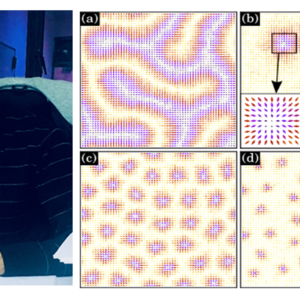FICORE spotlights! "Skyrmions and antiferromagnetic skyrmions in metals and insulators"
The event is organized in hybrid mode with options to attend,
-Physically in the Aalto University campus in Otaniemi (Nanotalo, Puumiehenkuja, 02150 Espoo) or
-Virtually in Zoom (https://aalto.zoom.us/j/63363479769)

When
Where
Event language(s)
Magnetic Skyrmions are topological textures in the magnetization of certain non-centrosymmetric magnets that were predicted in the 1980s and discovered during the last decade. To control these topologically protected textures for possible use in memory devices, it is important to understand their microscopic origin. Conventionally, such textures are described with the help of phenomenological Landau free energy functionals including various anisotropic interactions.
In recent years, there have been efforts toward achieving a microscopic electronic description of these topological textures. Prof. Sanjeev Kumar, from IISER Mohali, will discuss his research group's recent efforts to understand the formation of Skyrmions and Antiferromagnetic Skyrmions in non-centrosymmetric metals and insulators within a unified approach.
The approach of Prof. Sanjeev Kumar relies on two key concepts: strong Hund's rule coupling and spin-orbit coupling. He considers a model of electrons hopping on a two-dimensional lattice, experiencing spin-orbit coupling of Rashba or Dresselhaus type and a strong coupling to a background of classical spins. The model is directly simulated using a hybrid Monte Carlo technique and magnetic states possessing isolated Skyrmions as well as Skyrmion lattices are obtained.
To achieve an understanding of these, Prof. Kumar and his students derive an effective spin-only model by integrating the electrons. The model turns out to be a spin-orbit modified version of the famous double-exchange model that is very well studied in the context of magnetoresistive manganites. A different effective model, similar to a spin-orbit modified t-J model in the Mott limit, is obtained in the insulating limit. This limit supports the formation of antiferromagnetic Skyrmions configurations that can be viewed as superpositions of staggered antiferromagnet and skyrmions.
Finally, Prof. Kumar will discuss how interface engineering helps in inducing antiferromagnetic skyrmions in the metallic regimetallic regime's antiferromagnetic-skyrmion states.
Prof. Sanjeev Kumar is hosted by Dr. Manohar Kumar, an Academy Research Fellow at the Department of Applied Physics at Aalto University.
For more information on the event, please contact [email protected]
The event is hybrid with options to attend physically in the Aalto University campus in Otaniemi or to follow in Zoom.
Venue: Nanotalo, Puumiehenkuja, 02150 Espoo or
Join virtually in Zoom - https://aalto.zoom.us/j/63363479769
